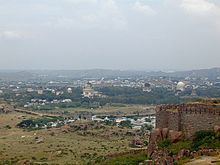 | ||
Illegal fencing near naya qila golkonda hyderabad protested by local farmers and activists
Naya Qila ("New Fort", also spelled Naya Quila) is an extended portion of Golkonda Fort in Hyderabad, India. Built in 1656 by Sultan Abdullah Qutb Shah as further defence for the Mughal armies. This Integral part of fort contains many historic structures.There are strange figures and animals worked out of stone and stucco on the walls of the outer fort facing the Naya Qila. It is one of the least explored heritage sites of India.
Contents
- Illegal fencing near naya qila golkonda hyderabad protested by local farmers and activists
- Naya qila hyderabad
- History
- Attraction
- References
Naya qila hyderabad
History
During the rule of Sultan Abdullah Qutb Shah (1625–1672), Mughal governor of the Deccan Plateau, Aurangzeb aimed the fusillade against Golkonda Fort in January 1656. The mighty Mughal army kept up the cannon-fire but the fort stood firm. After a four-month siege, the Mughal army withdrew in April 1656. Due to heavy fusillade by the Mughals, the fort became weak and Fort walls started leaning, thus to avoid future attacks and loss Sultan Abdullah Qutb Shah ordered for the repair of fort walls and the extension of Golkonda fort, thus the construction of Naya Qila was started in the year 1656 and was completed with more additions by Sultan Abul Hasan Qutb Shah. and nearly, 30 years later when Aurangzeb become the emperor, again he set his sights on the Golkonda he completely avoided the place because the place from where he aimed the fusillade, stood the Naya Qila. A rock masonry structure with moats, it made the Golkonda all the more impregnable. In 1687 Aurangzeb annexed Golkonda.
The fort was designed and constructed by Mustafa Khan, the royal architect of the Qutb Shahi dynasty; Makkah Masjid and Toli Masjid was designed and constructed by him.
Attraction
Both the mosques are critical examples of the early architecture of Golkonda.
The Hindu Writes on 22 Feb 2009 : The vast expanse of land abutting the Mustafa Khan Masjid in Naya Qila, Golconda, is the scene of hectic activity. Men and machines are busy levelling the land allegedly at the behest of the Hyderabad Golf Association (HGA). The Hindu writes on 12 Dec 2009 : Naya Qila: The Persian garden, the African Balboa tree, two mosques that back to the sunset days of Qutb Shahi regime are now threatened by a golf course of all things. A few gold coins unearthed at the site were on display at the State Museum during the heritage week, but the work is apace at the golf course. If tokenism is the norm, then this was it.
The News International Writes on 30 December 2008 : Earlier, the Hathiyan tree had the Naya Qila, historic mosques, Masjid-e-Mila Khayali and Masjid Mustafa Khan, for company. Now, there’s a half-built golf course too! And, that has blocked the entry of enthusiasts towards the Jamali Darwaza. It was in May this year that the route to the infamous elephant tree was obstructed, after construction was initiated by the Hyderabad Golf Association (HGA). Incidentally, the state government allotted nearly 100 acres at the Naya Qila to the HGA of which 50 acres was acquired from farmers.
The Times of India Writes on 19 Apr 2011 : Golconda garden vanishes from ASI files, A ten-acre garden in Golconda fort, dating back to the 17th century and described in the chapters of history as `Bagh-i-Qutub' has disappeared from the government files, literally. The Archaeological Survey of India (ASI), the caretaker of this `Deccani Garden' which many moons ago comprised cascading waterfalls and lakes but is now covered with creepers, has handed over this area to the Hyderabad Golf Association (HGA) claiming the `Bagh' never existed. The elite club, in turn, has planned four of its golf holes (5, 6, 14 and 15) in this area.
The Times of India Writes on 31 May 2011 : Naya Qila played down in UNESCO list. The Naya Qila has become history in Hyderabad's heritage map. The 600-page glossy dossier prepared by the state tourism department to bag the much-awaited world heritage tag for the 'Qutb Shahi Monuments of Hyderabad', just makes a namesake mention of this historical structure. The impressive dossier with pictures, maps and elaborate text has buried the Qila in a corner and even dangerously termed it as `buffer zone' (and not `core' area) around the 400-year-old Golconda Fort. Not only does the Naya Qila and its structures find no mention on the list of `nominated property of Golconda' (the 22 structures), the descriptive sections of the report, which trace the history of each property in intricate detail, has little to say about the Qila.
